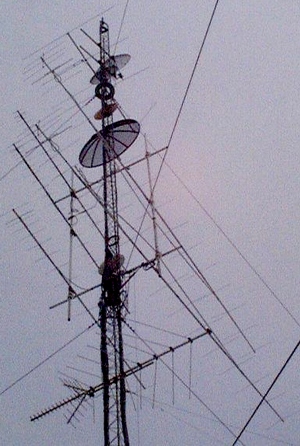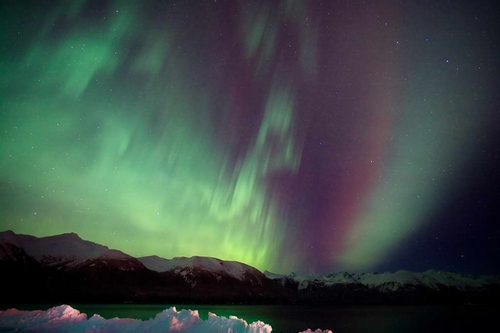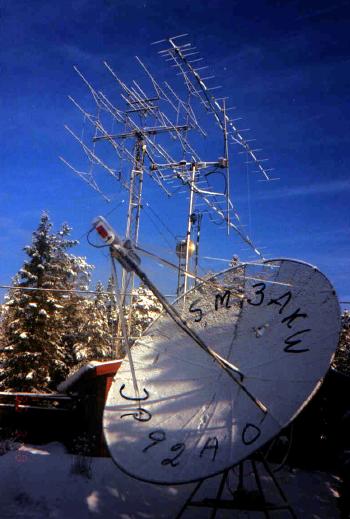|
METEOR SCATTER AND AURORA AT 902 MHz AND ABOVE [1992] by Dave Hallidy KD5RO/2 ; 2118 W. Jefferson Rd.; Pittsford, NY 14534) - http://www.frontiernet.net/~k2dh/ INTRODUCTION Many amateurs have experimented with long distance QSO’s using the Auroral Curtain or the ionized trails of meteors entering the Earth’s atmosphere. Contacts using these methods of propagation enhancement are made frequently on the amateur bands of 50, 144, 222, and to a lesser extent on 432 MHz. In this paper, I will bring you up to date on the efforts being made to expand the upper frequency limit of these contacts to include the amateur microwave bands at 902 MHz and beyond. IN THE BEGINNING Amateurs were actually the first to discover that signals could be propagated great distances by use of Auroral or Meteor trail reflections. We have been exploiting these propagation modes ever since. Meteor Scatter contacts in excess of 1200 miles and Auroral contacts in excess of 1000 miles are not uncommon on the VHF and lower UHF bands. MICROWAVE METEOR SCATTER Mike Owen, W9IP/2, has predicted that under the right conditions, Meteor trail ionization should propagate signals well into the upper UHF and lower microwave frequencies. His research, and that of others (Bob Mobile, WA1OUB as an example) have shown the existence of reflections, during the better showers, to at least 700 MHz. With the widespread predictions that the Perseids Meteor Shower of 1992 would be a memorable event, with many “rocks”, WB5LUA and I decided this would be a good opportunity to try a QSO at 902 MHz. One thing that seems to be accepted about propagation due to Meteor Trail Reflections is that a shower producing high and fast meteors is better for higher frequency propagation. Thus the reason we picked the Perseids it is well-known for these types of meteors. It is also a fairly predictable shower with a fairly broad peak and useable meteors for several days around the peak day. It should be noted that for all the predictions and “understanding” of Meteor Showers, unpredictable things happen. WB5LUA and I completed a QSO on 432 MHz during the Geminids Shower of December, 1988 which stands today as the MS record on that band (1239 miles) but that shower is known as a “low, slow” shower, not noted for propagation at 432. Yet, we made it, and surprisingly, heard many reasonable bursts or “pings” during our effort. So much for predictions. We knew that the number of meteors generating useable trails drops dramatically as frequency increases, and that the duration of any potential burst also gets shorter. We both run fairly high power on the 33cm band, Al has a TWTA producing about 175 Watts and I borrowed a Hi-Spec amplifier using a pair of air-cooled 7289’s and producing about 250 Watts. Al tried to have his “really high power” on the air for the test (a Varian klystron capable of over a kW output), but couldn’t finish construction of all the power supplies and support hardware in time. Knowing that signals would be weak (based on our 432 experience), Al mast-mounted a GaAsFET preamp at his location and I used 1-5/8” Andrew Heliax as my feedline (a 60 foot run, I wanted to use a mast-mounted preamp but didn’t have time to implement this). My transverter has a GaAsFET front end and a measured NF of 0.45dB. Al used a very long loop yagi as his antenna (47 elements and 15 foot boom, I believe). I used a six foot mesh TVRO dish with a 0.4 f/D and a dual 902/1296 feed designed by WA5VJB. We decided that we would stick with 15 second sequences for transmit and receive as is usually done on the lower frequencies. During our 432 QSO we had used 10 second sequencing, but decided that it really didn’t seem to offer any advantages, and it was certainly more confusing. Originally, we had planned to attempt QSO’s each of three days- the day before the peak, the peak day, and the day after the peak. Using W9IP/2’s Meteor Prediction program contained in the VHFPAK program, we calculated the best time to try a QSO as 1530Z on 12 August, 1992. My work commitments and Al’s efforts to get the klystron operational kept us from running before the peak day. On the peak day, the predictions said, we would have nearly a 100 percent “effectivity” rating over the Northeast? Southwest path between us, and we decided to run for three hours, starting at 1330Z. Each hour, we would compare notes by telephone to decide if modifications to our plan were necessary. I had hoped to bring news in this paper of completion of the first ever 902 MHz Meteor Scatter QSO, but the “propagation gods” were not with us. Neither WB5LUA nor I ever heard anything from the other. After reviewing our efforts, a possible explanation can be given. It seems that there was a discrepancy in the calculation of the shower’s peak time/date. Several people we have spoken to have stated that the Perseids shower peaked ONE DAY EARLIER, on 11 August. This is corroborated by statements from Emil Pocock, W3EP and by levels of activity and success noted by other operators on other bands. Why the discrepancy? We really don’t know, but it may be a bug in the way that the Meteor program handles Leap Year in its calculations. While we are both obviously disappointed, we are undaunted and plan to try several more skeds in the near future, as there are at least two more good showers with the requisite “high and fast” meteors. I hope to have a more positive report soon on this exciting endeavor. MICROWAVE AURORAL SCATTER
More has been accomplished in the area of microwave communications using the auroral curtain to reflect signals. Evidence suggests that the curtain should easily reflect signals at these frequencies. There are several factors which tend to make problems for those attempting Auroral QSO’s. The first of these is the beamwidth of antennas typically used for microwave communications. At two meters, it is very easy to keep an antenna pointed at the spot in the curtain providing the loudest signal from the station we want to work because the beamwidth of the antenna is fairly broad. Because the curtain is constantly shifting, it is much more difficult to keep a very narrow beamwidth antenna pointed at this “hot spot”. Second is the fact that relatively few microwave operators use high transmit power for their normal QSO’s. Since the efficiency of the curtain as a reflector appears to drop with increasing frequency (due to its constant motion and changing ionization levels), signals are generally weaker for a given power level than at lower frequencies. Therefore, stations planning to attempt microwave AU QSO’s are advised to run as much power as possible. Third, Doppler shift of the reflected signal requires the use of dual VFO’s to split the transmit and receive frequencies. We typically see three to five kHz of Doppler at 432. At 902, one would have to plan on at least twice that amount. Fourth, because of the motion of the curtain and the changing shape of the reflector, the reflected signal will be “smeared”. This smearing is what gives an auroral signal its characteristic hissing sound. As the frequency of the reflected signal increases, so does the smearing, or spreading of the signal. Less and less of the reflected energy will remain inside the receiver’s passband, so the recovered audio will be less and less- too narrow a bandwidth may make signals undetectable. During the Spring of 1986, a very strong Aurora produced numerous QSO’s on 432 between stations in the South, Midwest, Southwest and Northeastern parts of the US. WB5LUA established a new 432 Auroral DX record during that session, when he worked W3IP (FM19) at a distance of 1182 miles. While no microwave QSO’s were reported, W7CNK in Oklahoma City reported hearing someone calling “CQ AW’ on 1296. At the time, there were no stations active on the 33cm band. Sunspot Cycle 22 produced no more of these “Super Auroras” until the evening of 13 March, 1989 when a brilliant visible Aurora was seen as far south as Southern Florida. That evening, I connected with Rick Connor, WC2K in Southern New Jersey (FM29) on 220 and we immediately QSY’ed to 432 where signals were 20- 40dB above 59. We decided to try 903.1 and went there for about ten minutes. We did not complete a QSO, but we DID HEAR EACH OTHER. He was about 9-11 kHz below 903.100 and the signal was very broad, occupying at least 5-6 kHz (my best guess). When I was centered on his signal, it was very difficult to discern any real Morse characters- it was more a raising and lowering of the receiver noise floor. At my station, Rick was a 33A report. Rick later reported hearing similar signals from me. I should note that all the lower frequency excitement was what caused our ultimate failure to complete- there was so much activity, Rick went back to 220 and proceeded to work WB5LUA for the Auroral DX record on that band. The next really strong Aurora occurred much later in Cycle 22. On the evening of 24 March, 1991 I hooked up with Dennis Mungham, VE3ASO in Ottawa, Canada (FN25) on 432. His signal was EXTREMELY strong there, so we immediately went to 903.1 to try there. Once again, no QSO took place. I was only running about 50 Watts at that time and it appeared that the Aurora began dissipating almost as soon as we QSY’ed. However, with Dennis’ much greater power, I DID HEAR HIM. He was a 33A, and was characteristically smeared and much lower in frequency than where I was transmitting. That night, signals from as far south as the Carolinas and Georgia were heard on 432. Things subsided for a few months, then on 8 November, 1991 Harry K3HZO FINALLY COMPLETED A 903 AURORA QSO. Details have been sketchy regarding this QSO, but I do know that the other end of the linkup was WA3NZL and they did QSY up from 432. Harry stated that the Auroral returns on 432 were well above S9 and the 903 return was shifted by 2.5 to 13 kHz from the terrestrial signal which could be heard simultaneously. The only concern with this QSO is that both stations reside in the highly congested Philadelphia-Maryland-D.C. area and there is known to be a lot of aircraft multi-path there. The difference, I believe, is that both stations recognized the characteristic difference in signal smearing due to the Aurora. I would like to learn how much power and what type of antennas each station used in this QSO. CONCLUSIONS While no success has thus far been realized with a microwave Meteor Scatter QSO, I believe that it remains a possibility. I think that my efforts with WB5LUA would have had a good chance of success if we had been on the air the day before the computer program said we should. In the next few months, we will try again to complete a QSO via Meteor Scatter on 902 MHz. If we are successful, we will then focus our efforts on 1296.
The amateur community has witnessed the first 902 MHz Aurora QSO’ and we should congratulate the hams who accomplished this feat. We should now attempt to exploit this mode of communications, striving for longer distance QSO’s. The next frontier for Auroral communications is the 1296 band, a who is ready to try? With Cycle 22 winding down, we can expect better AU over the next few years, and this will be our opportunity to expand the horizons one more time. note of OK1TEH: 10 years later was done historical first Auroral contact on 23cm: First 1296-MHz Aurora Contact Carl Mohlin, SM3AKW, and Karl-Gosta Forssen, SM5QA, completed a historic first 1296-MHz aurora contact on April 11 at 1650. Signals were 33A both ways, with characteristic Doppler broadening and a 5-kHz Doppler shift. The pair ran 500 W each with four 27-element Yagis and a 2.3-meter dish. The two were 358 km apart. Carl had been attempting to make a 1296 MHz auroral contact for more than 20 years. Other stations had heard his signals via aurora from time to time, but he had not heard any 1296-MHz aurora until this past April 1, when he copied SM5QA. The pair completed 10 days later, after more than a year of efforts. [Source QST - http://www.qsl.net/vu2zap/QSTvu2zap.pdf] John,G3XDY noted in Scatter-point magazine: "SM3AKW has reported what is thought to be the first two way auroral QSO on 1.3GHz. This took place on 11th April between SM3AKW and SM5QA during a strong auroral opening. Signals were only 33A despite the use of high power (500W) and 20dB antenna gain. Doppler shift was of the order of 5kHz. The only other instance I recollect of auroral propagation on 1.3GHz was during the “Mega Aurora” of March 1989, when G4FUF was reported heard by HA2RD, but only 1 way. Congratulations to both stations, who have been trying for an Au QSO for several years." [Source http://www.microwavers.org/scatterpoint/early/issue5.pdf] Source: Proceedings of Microwave Update '92 - pages 85-88 (TNX Donn, WA2VOI/0 for scan!) With author's approval (for publication at OK2KKW web) edited by Matej, OK1TEH [2009] |


